Innovating for Growth: Q&A with Frank Seeley AM

From working out of a garage to producing 1.5 million parts per year, Seeley shares his insights in manufacturing, R&D and workplace culture with i+
Frank Seeley founded Seeley International, Australia's largest air conditioning and ducted gas heating manufacturer, in 1972, growing it to a business with 550 employees, exporting to 120 countries around the world.
Innovation Intelligence sat down with Seeley to discuss his approach to innovation, dispel myths around Australian manufacturing, and advice for Australia's next-generation.
What’s your key message to Australia’s rising entrepreneurs and aspiring manufacturing innovation leaders?
People might first laugh at your business idea like I myself experienced. You’ve got to have self-belief. You need to be a lateral thinker. You might lose friends by going on your own but you cannot be afraid. Don’t rule anything out.
You need to be intentionally dissatisfied and always seek perfection. I had an urge to find ways of doing things differently. I spent many hours learning from the experts and relentlessly pursued a completely unconventional idea of making a cooler entirely out of plastic. Now I lead a group of the country’s top innovators, called “Imagineering”, at Seeley International.
How do you approach enterprise risk?
I’ve always considered risk to be both a good servant and a bad master. If you’re not prepared to take risk, you need to do follow a lesser adventurous calling. One of the biggest risks is getting complacent after experiencing success and thinking you have made it. You need to be always asking “where’s the next threat to my business?” and “where’s the next opportunity for greater commercial success?”.
Another mistake people make is assuming that decisions involving risk can be made on their own. Throughout my career, I constantly seek the expert advice from clever people around me. Not socialising these decisions with your peers is one of the riskiest behaviours that anyone can indulge on. This boils down to ego and arrogance. Humility is a key leadership trait for managing risk decisions as well as progressive businesses.
How should manufacturing businesses approach R&D?
It’s simple: you get out of anything what you’re prepared to put in. Some companies make the mistake of only having a discretionary R&D function or one that is contingent on the performance of the whole company.
And while it’s important for that R&D function to be helping the business continuously improve with incremental enhancements and refinements, the real pay-off of R&D, to measurably accelerate the company, is discovering and implementing advanced “blue sky” concepts to effect a disruption that, may even be 5-10 years away from commercialisation.
What are the less obvious benefits with having a culture of innovation at the workplace?
Innovation has resulted in things like automation which, by definition, takes away traditional labour jobs. Some are opposed to this trend. But it means those people can get re-trained for new jobs with higher function that comes with greater levels of job stimulation and satisfaction and therefore employee morale, which, inevitably, heightens retention rates.
Innovation is not just limited to smarter manufacturing methods and products. Innovation is something for everyone in the company. Innovation in the workplace also applies to leadership, especially managing people and politics. Humour and always being approachable (emotional intelligence), are two uniquely effective leadership traits that help unite us all.
How do you see the future of Australia's manufacturing industry?
The government has a good history of generously supporting Australian manufacturing including provision of grants. The government needs to continue with this R&D facilitation role as it stands to benefit it, as well as all of us, in the long run. Also key to positive future outcomes is for our young people adopting JFK’s principle “what can I do for the manufacturing industry … where can I make the greatest contribution?”.
We should be proud of our manufacturing past and excited about our manufacturing future. We have a long and rich history of excellence in manufacturing innovation such as over the horizon radar. There will always be threats to our manufacturing industry, like becoming complacent and cheaper offshore labour, but for every one of them, there is a defence. Staying ahead of and anticipating threats is key.
Of all engine rooms of the innovation economy, manufacturing is arguably the most fertile. We need to seize it. It’s where the future of the world is and where Australia ought to be!
Find out more about
Seeley International










